Business Finance: Investment Appraisal, Risk, and Financial Ratios
VerifiedAdded on 2023/06/18
|20
|3918
|241
Report
AI Summary
This report provides a comprehensive analysis of various business finance concepts and techniques. It includes the computation of net cash inflow, determination of the internal rate of return (IRR), and evaluation of the financial viability of a project. The report also compares different methods for accounting for risk and calculates the average operating cycle in days, along with current and acid test ratios. Furthermore, it discusses the types of risks and costs that can be reduced by lowering inventory levels. The report calculates the theoretical ex-right price of an ordinary share and the value of rights associated with holding shares, evaluating the options available to investors. Finally, it calculates and analyzes financial ratios for a company, providing insights into its financial position. Desklib offers a wealth of similar solved assignments and past papers to aid students in their studies.
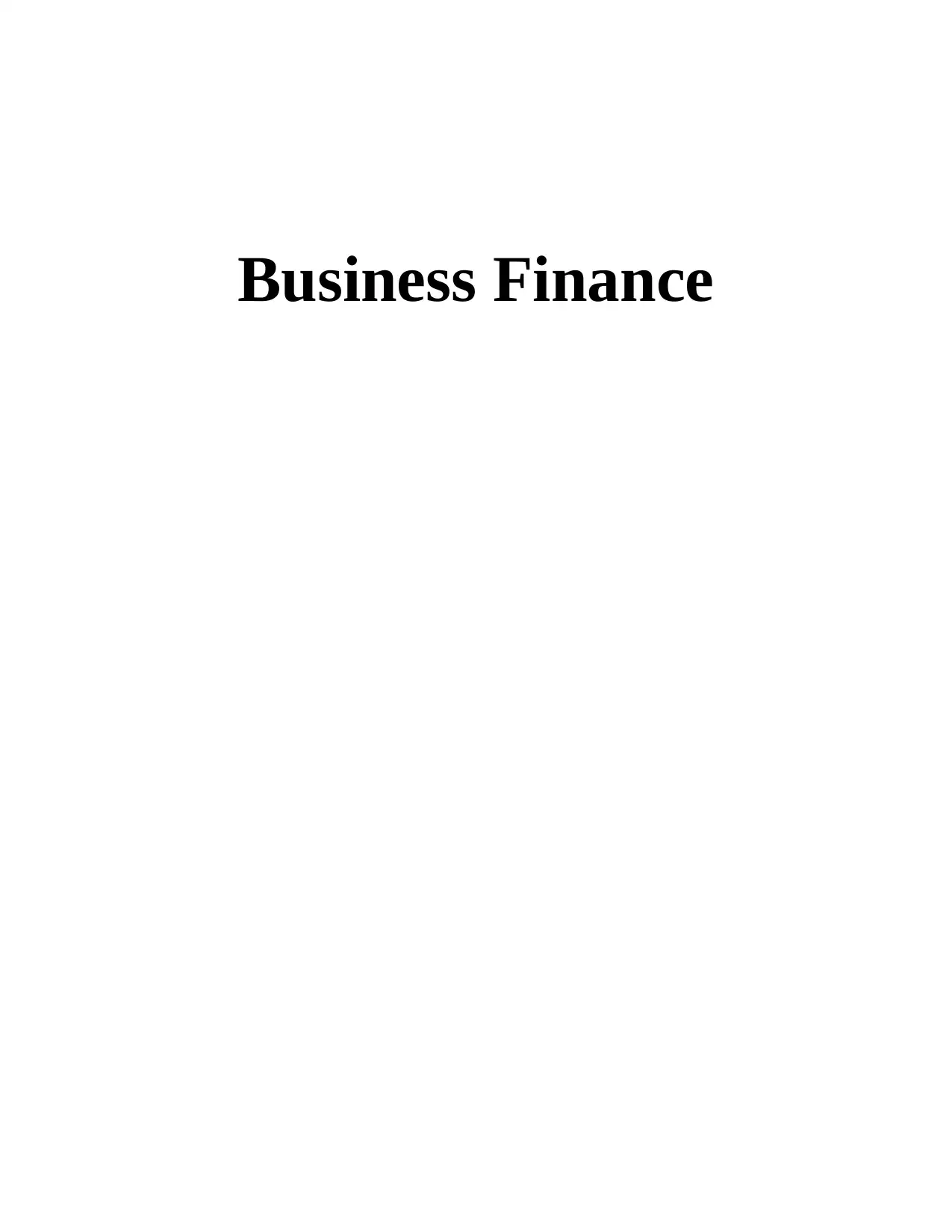
Business Finance
Paraphrase This Document
Need a fresh take? Get an instant paraphrase of this document with our AI Paraphraser

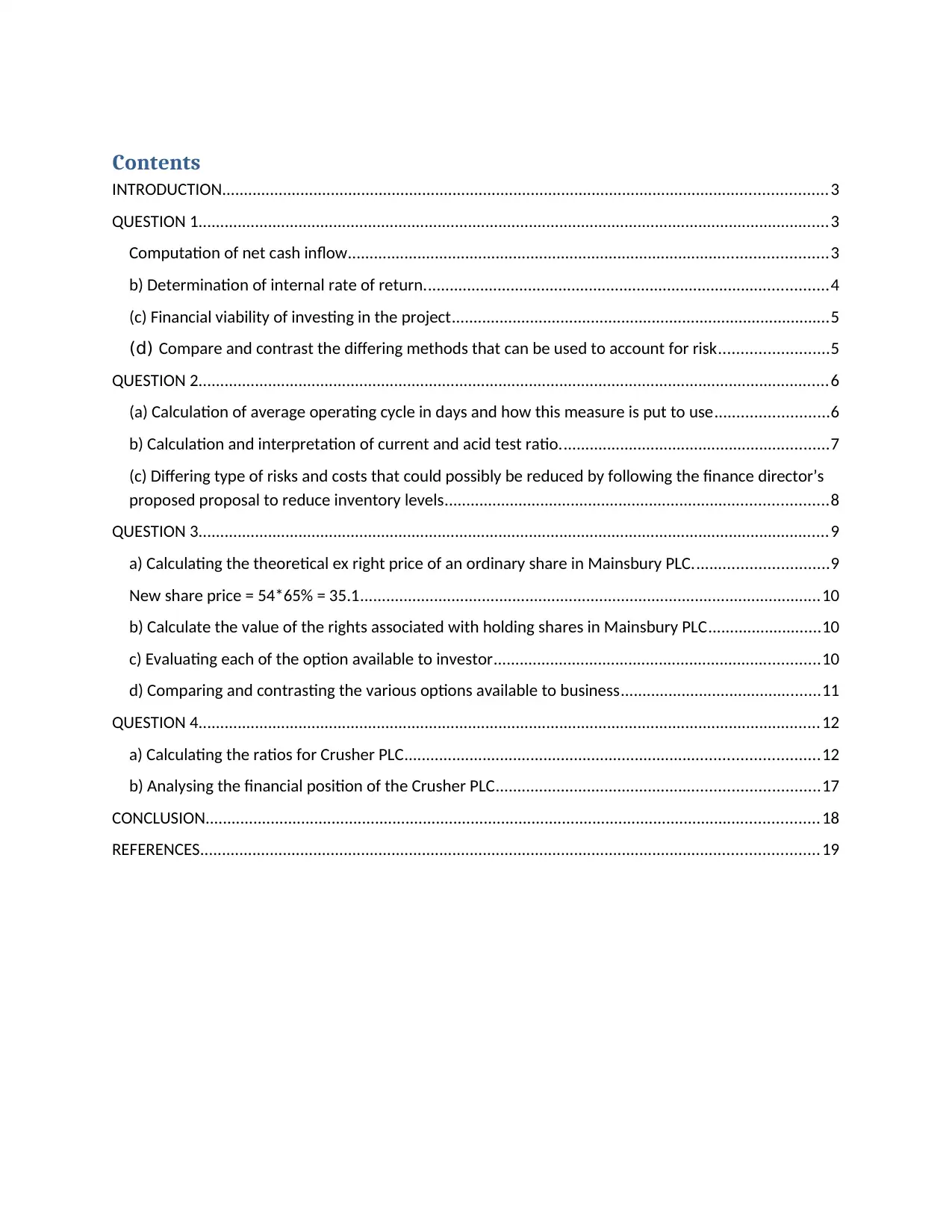
Contents
INTRODUCTION...........................................................................................................................................3
QUESTION 1.................................................................................................................................................3
Computation of net cash inflow..............................................................................................................3
b) Determination of internal rate of return.............................................................................................4
(c) Financial viability of investing in the project.......................................................................................5
(d) Compare and contrast the differing methods that can be used to account for risk.........................5
QUESTION 2.................................................................................................................................................6
(a) Calculation of average operating cycle in days and how this measure is put to use..........................6
b) Calculation and interpretation of current and acid test ratio..............................................................7
(c) Differing type of risks and costs that could possibly be reduced by following the finance director’s
proposed proposal to reduce inventory levels........................................................................................8
QUESTION 3.................................................................................................................................................9
a) Calculating the theoretical ex right price of an ordinary share in Mainsbury PLC...............................9
New share price = 54*65% = 35.1..........................................................................................................10
b) Calculate the value of the rights associated with holding shares in Mainsbury PLC..........................10
c) Evaluating each of the option available to investor...........................................................................10
d) Comparing and contrasting the various options available to business..............................................11
QUESTION 4...............................................................................................................................................12
a) Calculating the ratios for Crusher PLC...............................................................................................12
b) Analysing the financial position of the Crusher PLC..........................................................................17
CONCLUSION.............................................................................................................................................18
REFERENCES..............................................................................................................................................19
INTRODUCTION...........................................................................................................................................3
QUESTION 1.................................................................................................................................................3
Computation of net cash inflow..............................................................................................................3
b) Determination of internal rate of return.............................................................................................4
(c) Financial viability of investing in the project.......................................................................................5
(d) Compare and contrast the differing methods that can be used to account for risk.........................5
QUESTION 2.................................................................................................................................................6
(a) Calculation of average operating cycle in days and how this measure is put to use..........................6
b) Calculation and interpretation of current and acid test ratio..............................................................7
(c) Differing type of risks and costs that could possibly be reduced by following the finance director’s
proposed proposal to reduce inventory levels........................................................................................8
QUESTION 3.................................................................................................................................................9
a) Calculating the theoretical ex right price of an ordinary share in Mainsbury PLC...............................9
New share price = 54*65% = 35.1..........................................................................................................10
b) Calculate the value of the rights associated with holding shares in Mainsbury PLC..........................10
c) Evaluating each of the option available to investor...........................................................................10
d) Comparing and contrasting the various options available to business..............................................11
QUESTION 4...............................................................................................................................................12
a) Calculating the ratios for Crusher PLC...............................................................................................12
b) Analysing the financial position of the Crusher PLC..........................................................................17
CONCLUSION.............................................................................................................................................18
REFERENCES..............................................................................................................................................19
⊘ This is a preview!⊘
Do you want full access?
Subscribe today to unlock all pages.

Trusted by 1+ million students worldwide

INTRODUCTION
The method through which a financial supervisor delivers funds for business usage as and
when this is required is known as business finance. This provision must be made in accordance
with necessities. Budgetary Control, but in the other extreme, is an economics area concerned
with the creation and distribution of finite resources to the most efficient user inside this business
(or the firm). A market-based pricing structure is used to allocate those commodities. A business
needs capital in the form of cash collected from investors (Siddik and Kabiraj, 2020). Only
within company, funding must be directed to initiatives that will generate the best results. In this
report consist of different methods of calculations like cash flow method, NPV, internal rate of
return. Along with analysis different types of ratios to analysis the performance of business.
QUESTION 1
Computation of net cash inflow
Particulars
Year
2011
Year
2012
Year
2013
Year
2014
Year
2015
Sales (no. of units *
rate) (In£)
360000
0
427500
0
562500
0
405000
0
270000
0
Less: expenses (in£)
Variable labor cost 375 375 375 375 375
Variable material cost 250 250 250 250 250
Lease 550000 550000 550000 550000 550000
Administrative cost 600000 600000 600000 600000 600000
Total expenses
115062
5
115062
5
115062
5
115062
5
115062
5
Less: Depreciation 500000 500000 500000 500000 500000
Earnings before interest
and tax
194937
5
262437
5
397437
5
239937
5
104937
5
Less: Interest 0 0 0 0 0
The method through which a financial supervisor delivers funds for business usage as and
when this is required is known as business finance. This provision must be made in accordance
with necessities. Budgetary Control, but in the other extreme, is an economics area concerned
with the creation and distribution of finite resources to the most efficient user inside this business
(or the firm). A market-based pricing structure is used to allocate those commodities. A business
needs capital in the form of cash collected from investors (Siddik and Kabiraj, 2020). Only
within company, funding must be directed to initiatives that will generate the best results. In this
report consist of different methods of calculations like cash flow method, NPV, internal rate of
return. Along with analysis different types of ratios to analysis the performance of business.
QUESTION 1
Computation of net cash inflow
Particulars
Year
2011
Year
2012
Year
2013
Year
2014
Year
2015
Sales (no. of units *
rate) (In£)
360000
0
427500
0
562500
0
405000
0
270000
0
Less: expenses (in£)
Variable labor cost 375 375 375 375 375
Variable material cost 250 250 250 250 250
Lease 550000 550000 550000 550000 550000
Administrative cost 600000 600000 600000 600000 600000
Total expenses
115062
5
115062
5
115062
5
115062
5
115062
5
Less: Depreciation 500000 500000 500000 500000 500000
Earnings before interest
and tax
194937
5
262437
5
397437
5
239937
5
104937
5
Less: Interest 0 0 0 0 0
Paraphrase This Document
Need a fresh take? Get an instant paraphrase of this document with our AI Paraphraser

Earning before tax
194937
5
262437
5
397437
5
239937
5
104937
5
Less: Tax 0 0 0 0 0
Earning after tax
194937
5
262437
5
397437
5
239937
5
104937
5
Add: Depreciation 500000 500000 500000 500000 500000
Net cash inflows
244937
5
312437
5
447437
5
289937
5
154937
5
Year Net cash
inflows
Present
value
factor
Discounted
cash
inflows
2011 2449375 0.926 2267939.81
5
2012 3124375 0.857 2678647.97
7
2013 4474375 0.794 3551903.13
3
2014 2899375 0.735 2131127.17
9
2015 1549375 0.681 1054478.59
1
Total of present value factor &
discounted cash inflows
14496875 11684096.7
Computation of Net present
value
194937
5
262437
5
397437
5
239937
5
104937
5
Less: Tax 0 0 0 0 0
Earning after tax
194937
5
262437
5
397437
5
239937
5
104937
5
Add: Depreciation 500000 500000 500000 500000 500000
Net cash inflows
244937
5
312437
5
447437
5
289937
5
154937
5
Year Net cash
inflows
Present
value
factor
Discounted
cash
inflows
2011 2449375 0.926 2267939.81
5
2012 3124375 0.857 2678647.97
7
2013 4474375 0.794 3551903.13
3
2014 2899375 0.735 2131127.17
9
2015 1549375 0.681 1054478.59
1
Total of present value factor &
discounted cash inflows
14496875 11684096.7
Computation of Net present
value
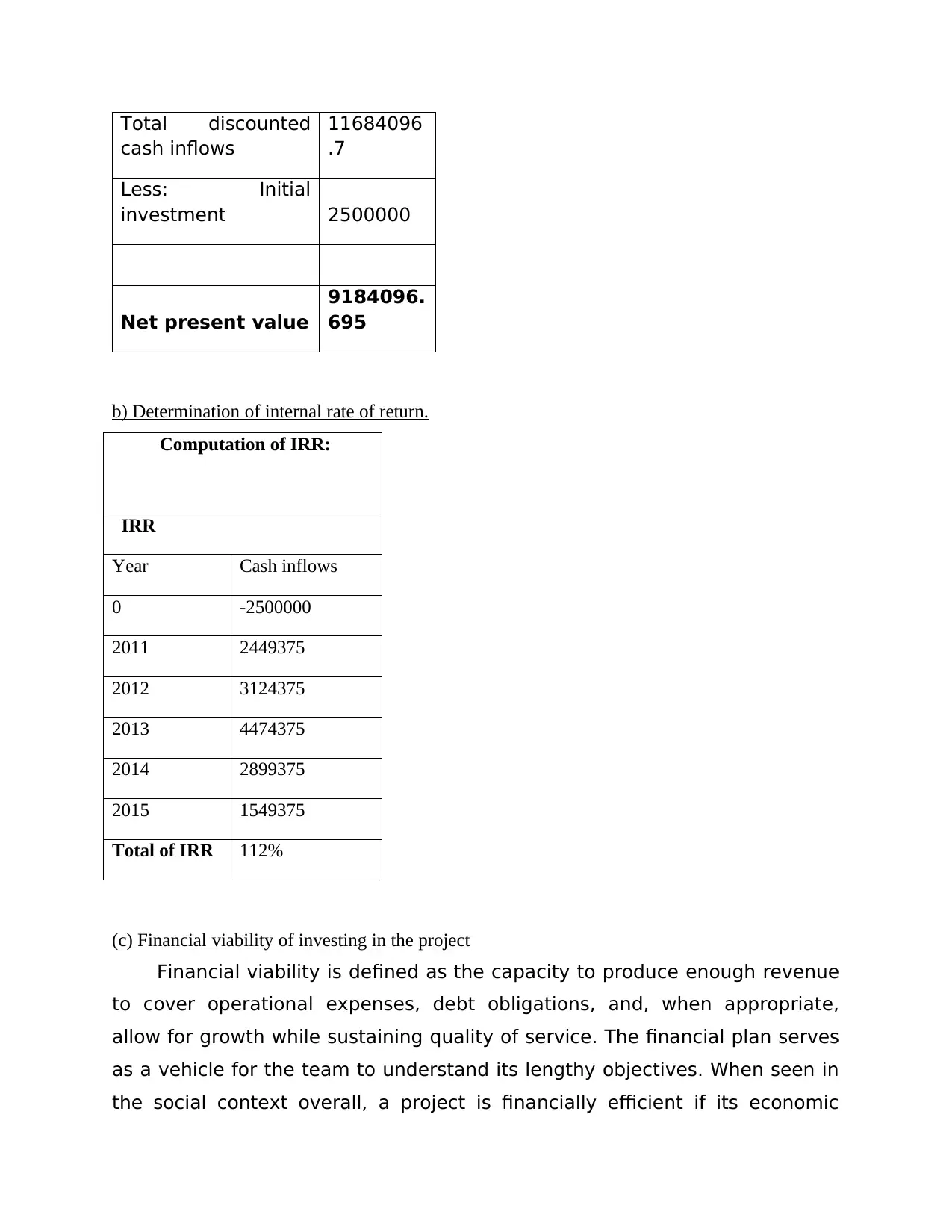
Total discounted
cash inflows
11684096
.7
Less: Initial
investment 2500000
Net present value
9184096.
695
b) Determination of internal rate of return.
Computation of IRR:
IRR
Year Cash inflows
0 -2500000
2011 2449375
2012 3124375
2013 4474375
2014 2899375
2015 1549375
Total of IRR 112%
(c) Financial viability of investing in the project
Financial viability is defined as the capacity to produce enough revenue
to cover operational expenses, debt obligations, and, when appropriate,
allow for growth while sustaining quality of service. The financial plan serves
as a vehicle for the team to understand its lengthy objectives. When seen in
the social context overall, a project is financially efficient if its economic
cash inflows
11684096
.7
Less: Initial
investment 2500000
Net present value
9184096.
695
b) Determination of internal rate of return.
Computation of IRR:
IRR
Year Cash inflows
0 -2500000
2011 2449375
2012 3124375
2013 4474375
2014 2899375
2015 1549375
Total of IRR 112%
(c) Financial viability of investing in the project
Financial viability is defined as the capacity to produce enough revenue
to cover operational expenses, debt obligations, and, when appropriate,
allow for growth while sustaining quality of service. The financial plan serves
as a vehicle for the team to understand its lengthy objectives. When seen in
the social context overall, a project is financially efficient if its economic
⊘ This is a preview!⊘
Do you want full access?
Subscribe today to unlock all pages.

Trusted by 1+ million students worldwide
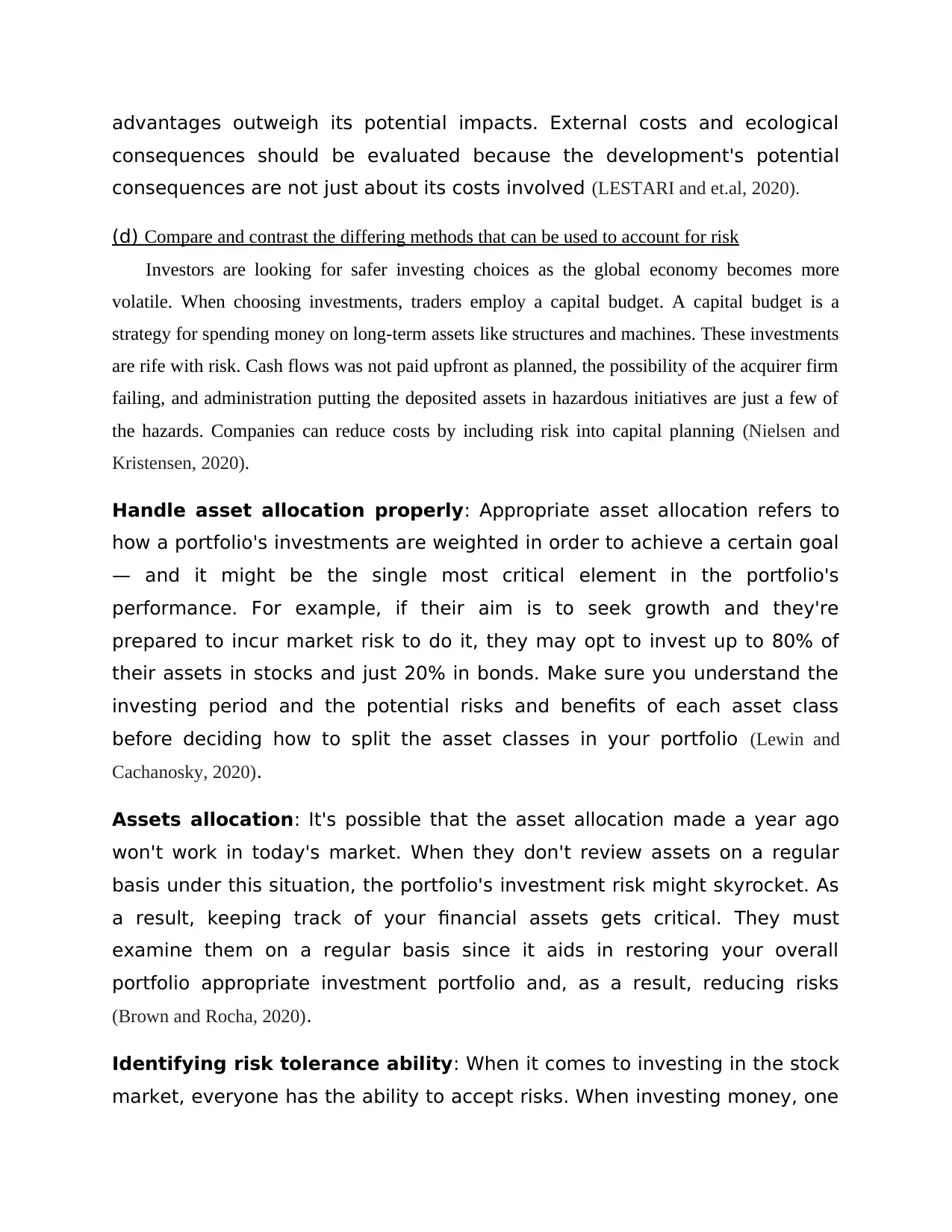
advantages outweigh its potential impacts. External costs and ecological
consequences should be evaluated because the development's potential
consequences are not just about its costs involved (LESTARI and et.al, 2020).
(d) Compare and contrast the differing methods that can be used to account for risk
Investors are looking for safer investing choices as the global economy becomes more
volatile. When choosing investments, traders employ a capital budget. A capital budget is a
strategy for spending money on long-term assets like structures and machines. These investments
are rife with risk. Cash flows was not paid upfront as planned, the possibility of the acquirer firm
failing, and administration putting the deposited assets in hazardous initiatives are just a few of
the hazards. Companies can reduce costs by including risk into capital planning (Nielsen and
Kristensen, 2020).
Handle asset allocation properly: Appropriate asset allocation refers to
how a portfolio's investments are weighted in order to achieve a certain goal
— and it might be the single most critical element in the portfolio's
performance. For example, if their aim is to seek growth and they're
prepared to incur market risk to do it, they may opt to invest up to 80% of
their assets in stocks and just 20% in bonds. Make sure you understand the
investing period and the potential risks and benefits of each asset class
before deciding how to split the asset classes in your portfolio (Lewin and
Cachanosky, 2020).
Assets allocation: It's possible that the asset allocation made a year ago
won't work in today's market. When they don't review assets on a regular
basis under this situation, the portfolio's investment risk might skyrocket. As
a result, keeping track of your financial assets gets critical. They must
examine them on a regular basis since it aids in restoring your overall
portfolio appropriate investment portfolio and, as a result, reducing risks
(Brown and Rocha, 2020).
Identifying risk tolerance ability: When it comes to investing in the stock
market, everyone has the ability to accept risks. When investing money, one
consequences should be evaluated because the development's potential
consequences are not just about its costs involved (LESTARI and et.al, 2020).
(d) Compare and contrast the differing methods that can be used to account for risk
Investors are looking for safer investing choices as the global economy becomes more
volatile. When choosing investments, traders employ a capital budget. A capital budget is a
strategy for spending money on long-term assets like structures and machines. These investments
are rife with risk. Cash flows was not paid upfront as planned, the possibility of the acquirer firm
failing, and administration putting the deposited assets in hazardous initiatives are just a few of
the hazards. Companies can reduce costs by including risk into capital planning (Nielsen and
Kristensen, 2020).
Handle asset allocation properly: Appropriate asset allocation refers to
how a portfolio's investments are weighted in order to achieve a certain goal
— and it might be the single most critical element in the portfolio's
performance. For example, if their aim is to seek growth and they're
prepared to incur market risk to do it, they may opt to invest up to 80% of
their assets in stocks and just 20% in bonds. Make sure you understand the
investing period and the potential risks and benefits of each asset class
before deciding how to split the asset classes in your portfolio (Lewin and
Cachanosky, 2020).
Assets allocation: It's possible that the asset allocation made a year ago
won't work in today's market. When they don't review assets on a regular
basis under this situation, the portfolio's investment risk might skyrocket. As
a result, keeping track of your financial assets gets critical. They must
examine them on a regular basis since it aids in restoring your overall
portfolio appropriate investment portfolio and, as a result, reducing risks
(Brown and Rocha, 2020).
Identifying risk tolerance ability: When it comes to investing in the stock
market, everyone has the ability to accept risks. When investing money, one
Paraphrase This Document
Need a fresh take? Get an instant paraphrase of this document with our AI Paraphraser
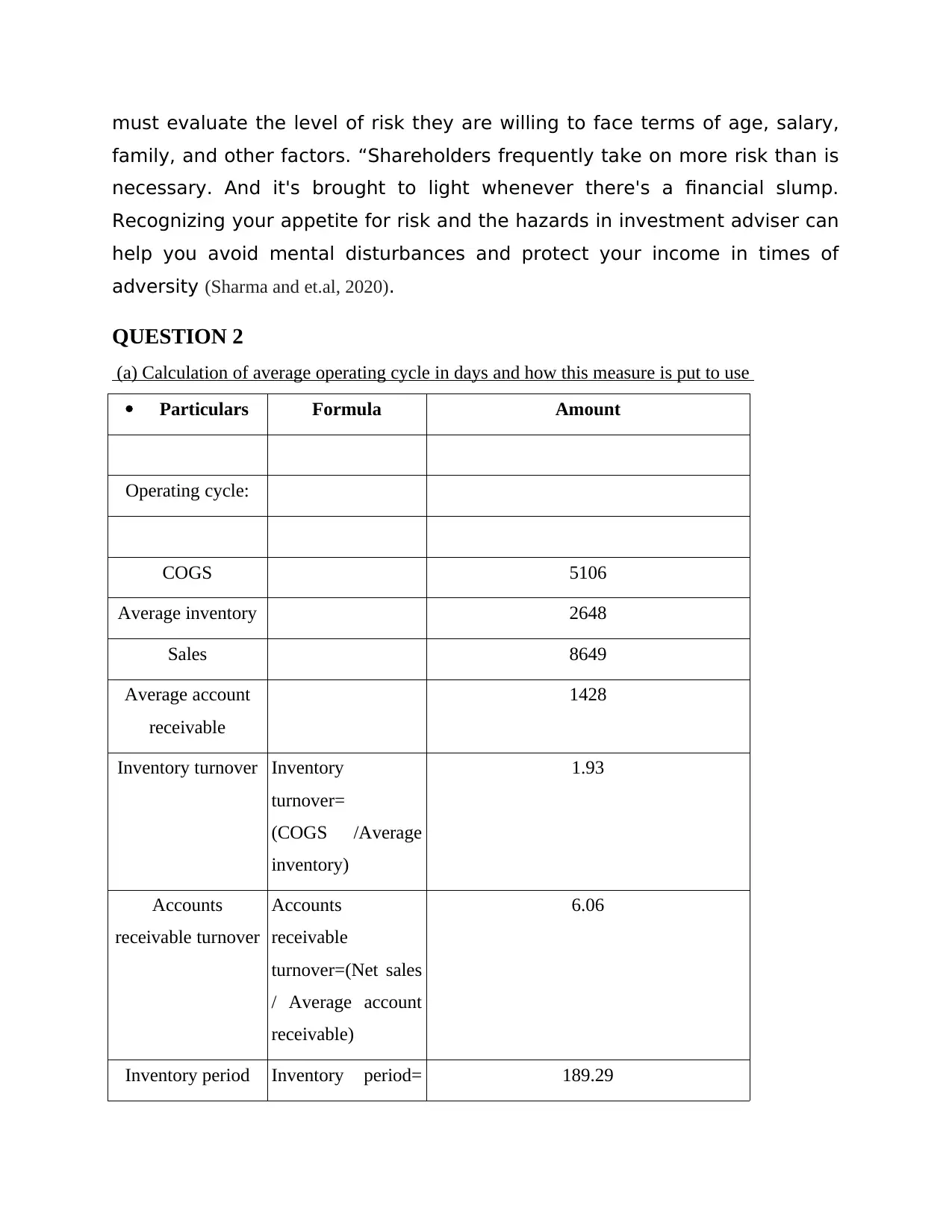
must evaluate the level of risk they are willing to face terms of age, salary,
family, and other factors. “Shareholders frequently take on more risk than is
necessary. And it's brought to light whenever there's a financial slump.
Recognizing your appetite for risk and the hazards in investment adviser can
help you avoid mental disturbances and protect your income in times of
adversity (Sharma and et.al, 2020).
QUESTION 2
(a) Calculation of average operating cycle in days and how this measure is put to use
Particulars Formula Amount
Operating cycle:
COGS 5106
Average inventory 2648
Sales 8649
Average account
receivable
1428
Inventory turnover Inventory
turnover=
(COGS /Average
inventory)
1.93
Accounts
receivable turnover
Accounts
receivable
turnover=(Net sales
/ Average account
receivable)
6.06
Inventory period Inventory period= 189.29
family, and other factors. “Shareholders frequently take on more risk than is
necessary. And it's brought to light whenever there's a financial slump.
Recognizing your appetite for risk and the hazards in investment adviser can
help you avoid mental disturbances and protect your income in times of
adversity (Sharma and et.al, 2020).
QUESTION 2
(a) Calculation of average operating cycle in days and how this measure is put to use
Particulars Formula Amount
Operating cycle:
COGS 5106
Average inventory 2648
Sales 8649
Average account
receivable
1428
Inventory turnover Inventory
turnover=
(COGS /Average
inventory)
1.93
Accounts
receivable turnover
Accounts
receivable
turnover=(Net sales
/ Average account
receivable)
6.06
Inventory period Inventory period= 189.29
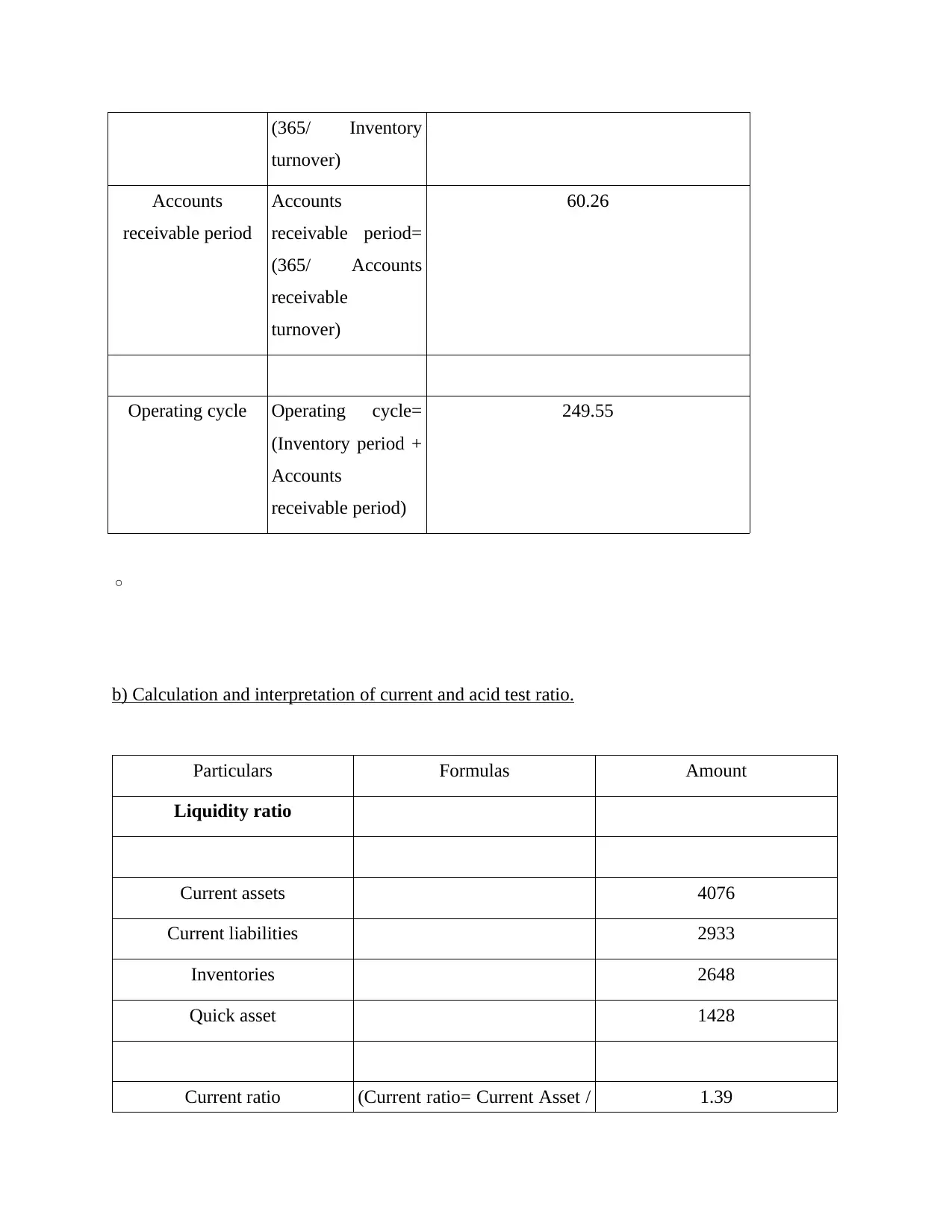
(365/ Inventory
turnover)
Accounts
receivable period
Accounts
receivable period=
(365/ Accounts
receivable
turnover)
60.26
Operating cycle Operating cycle=
(Inventory period +
Accounts
receivable period)
249.55
◦
b) Calculation and interpretation of current and acid test ratio.
Particulars Formulas Amount
Liquidity ratio
Current assets 4076
Current liabilities 2933
Inventories 2648
Quick asset 1428
Current ratio (Current ratio= Current Asset / 1.39
turnover)
Accounts
receivable period
Accounts
receivable period=
(365/ Accounts
receivable
turnover)
60.26
Operating cycle Operating cycle=
(Inventory period +
Accounts
receivable period)
249.55
◦
b) Calculation and interpretation of current and acid test ratio.
Particulars Formulas Amount
Liquidity ratio
Current assets 4076
Current liabilities 2933
Inventories 2648
Quick asset 1428
Current ratio (Current ratio= Current Asset / 1.39
⊘ This is a preview!⊘
Do you want full access?
Subscribe today to unlock all pages.

Trusted by 1+ million students worldwide
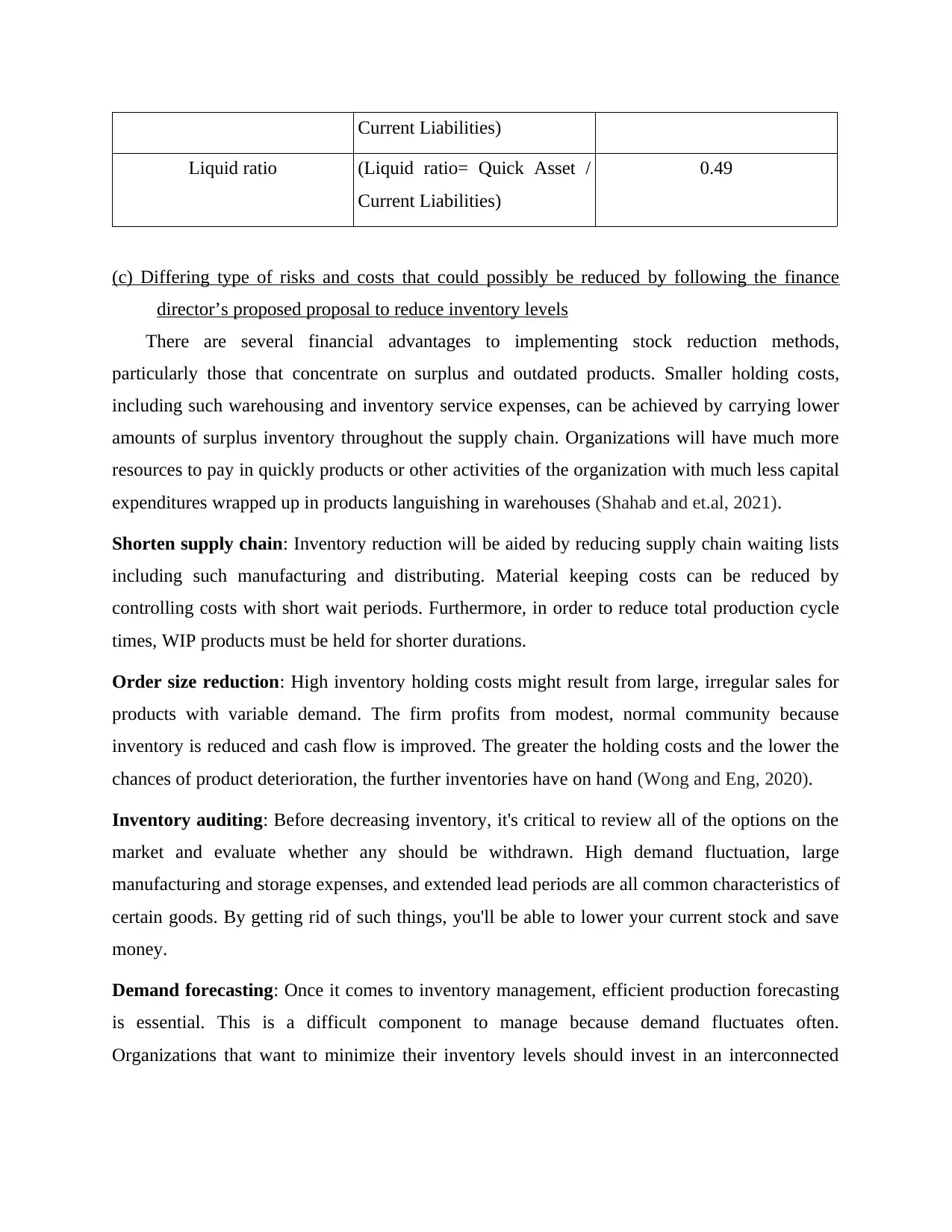
Current Liabilities)
Liquid ratio (Liquid ratio= Quick Asset /
Current Liabilities)
0.49
(c) Differing type of risks and costs that could possibly be reduced by following the finance
director’s proposed proposal to reduce inventory levels
There are several financial advantages to implementing stock reduction methods,
particularly those that concentrate on surplus and outdated products. Smaller holding costs,
including such warehousing and inventory service expenses, can be achieved by carrying lower
amounts of surplus inventory throughout the supply chain. Organizations will have much more
resources to pay in quickly products or other activities of the organization with much less capital
expenditures wrapped up in products languishing in warehouses (Shahab and et.al, 2021).
Shorten supply chain: Inventory reduction will be aided by reducing supply chain waiting lists
including such manufacturing and distributing. Material keeping costs can be reduced by
controlling costs with short wait periods. Furthermore, in order to reduce total production cycle
times, WIP products must be held for shorter durations.
Order size reduction: High inventory holding costs might result from large, irregular sales for
products with variable demand. The firm profits from modest, normal community because
inventory is reduced and cash flow is improved. The greater the holding costs and the lower the
chances of product deterioration, the further inventories have on hand (Wong and Eng, 2020).
Inventory auditing: Before decreasing inventory, it's critical to review all of the options on the
market and evaluate whether any should be withdrawn. High demand fluctuation, large
manufacturing and storage expenses, and extended lead periods are all common characteristics of
certain goods. By getting rid of such things, you'll be able to lower your current stock and save
money.
Demand forecasting: Once it comes to inventory management, efficient production forecasting
is essential. This is a difficult component to manage because demand fluctuates often.
Organizations that want to minimize their inventory levels should invest in an interconnected
Liquid ratio (Liquid ratio= Quick Asset /
Current Liabilities)
0.49
(c) Differing type of risks and costs that could possibly be reduced by following the finance
director’s proposed proposal to reduce inventory levels
There are several financial advantages to implementing stock reduction methods,
particularly those that concentrate on surplus and outdated products. Smaller holding costs,
including such warehousing and inventory service expenses, can be achieved by carrying lower
amounts of surplus inventory throughout the supply chain. Organizations will have much more
resources to pay in quickly products or other activities of the organization with much less capital
expenditures wrapped up in products languishing in warehouses (Shahab and et.al, 2021).
Shorten supply chain: Inventory reduction will be aided by reducing supply chain waiting lists
including such manufacturing and distributing. Material keeping costs can be reduced by
controlling costs with short wait periods. Furthermore, in order to reduce total production cycle
times, WIP products must be held for shorter durations.
Order size reduction: High inventory holding costs might result from large, irregular sales for
products with variable demand. The firm profits from modest, normal community because
inventory is reduced and cash flow is improved. The greater the holding costs and the lower the
chances of product deterioration, the further inventories have on hand (Wong and Eng, 2020).
Inventory auditing: Before decreasing inventory, it's critical to review all of the options on the
market and evaluate whether any should be withdrawn. High demand fluctuation, large
manufacturing and storage expenses, and extended lead periods are all common characteristics of
certain goods. By getting rid of such things, you'll be able to lower your current stock and save
money.
Demand forecasting: Once it comes to inventory management, efficient production forecasting
is essential. This is a difficult component to manage because demand fluctuates often.
Organizations that want to minimize their inventory levels should invest in an interconnected
Paraphrase This Document
Need a fresh take? Get an instant paraphrase of this document with our AI Paraphraser
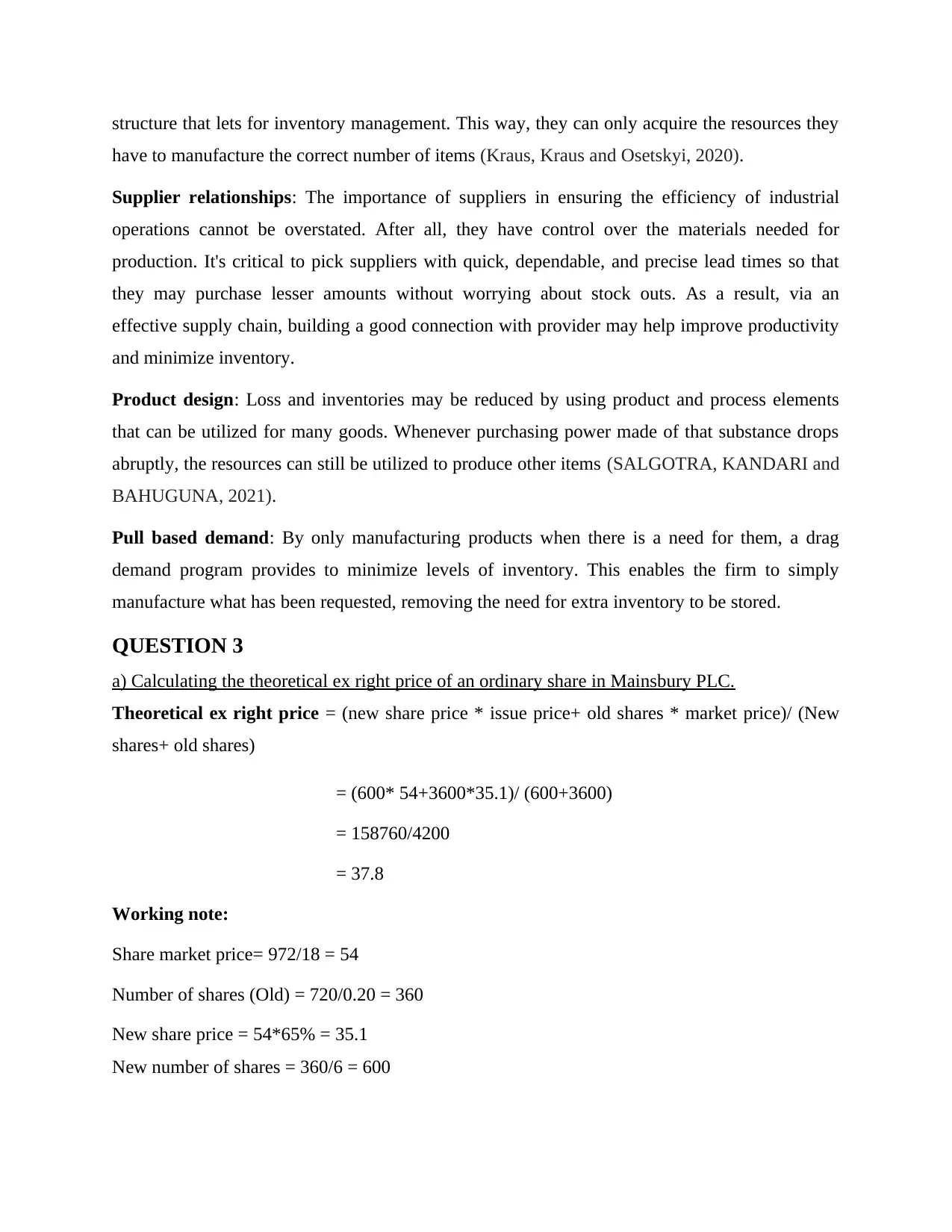
structure that lets for inventory management. This way, they can only acquire the resources they
have to manufacture the correct number of items (Kraus, Kraus and Osetskyi, 2020).
Supplier relationships: The importance of suppliers in ensuring the efficiency of industrial
operations cannot be overstated. After all, they have control over the materials needed for
production. It's critical to pick suppliers with quick, dependable, and precise lead times so that
they may purchase lesser amounts without worrying about stock outs. As a result, via an
effective supply chain, building a good connection with provider may help improve productivity
and minimize inventory.
Product design: Loss and inventories may be reduced by using product and process elements
that can be utilized for many goods. Whenever purchasing power made of that substance drops
abruptly, the resources can still be utilized to produce other items (SALGOTRA, KANDARI and
BAHUGUNA, 2021).
Pull based demand: By only manufacturing products when there is a need for them, a drag
demand program provides to minimize levels of inventory. This enables the firm to simply
manufacture what has been requested, removing the need for extra inventory to be stored.
QUESTION 3
a) Calculating the theoretical ex right price of an ordinary share in Mainsbury PLC.
Theoretical ex right price = (new share price * issue price+ old shares * market price)/ (New
shares+ old shares)
= (600* 54+3600*35.1)/ (600+3600)
= 158760/4200
= 37.8
Working note:
Share market price= 972/18 = 54
Number of shares (Old) = 720/0.20 = 360
New share price = 54*65% = 35.1
New number of shares = 360/6 = 600
have to manufacture the correct number of items (Kraus, Kraus and Osetskyi, 2020).
Supplier relationships: The importance of suppliers in ensuring the efficiency of industrial
operations cannot be overstated. After all, they have control over the materials needed for
production. It's critical to pick suppliers with quick, dependable, and precise lead times so that
they may purchase lesser amounts without worrying about stock outs. As a result, via an
effective supply chain, building a good connection with provider may help improve productivity
and minimize inventory.
Product design: Loss and inventories may be reduced by using product and process elements
that can be utilized for many goods. Whenever purchasing power made of that substance drops
abruptly, the resources can still be utilized to produce other items (SALGOTRA, KANDARI and
BAHUGUNA, 2021).
Pull based demand: By only manufacturing products when there is a need for them, a drag
demand program provides to minimize levels of inventory. This enables the firm to simply
manufacture what has been requested, removing the need for extra inventory to be stored.
QUESTION 3
a) Calculating the theoretical ex right price of an ordinary share in Mainsbury PLC.
Theoretical ex right price = (new share price * issue price+ old shares * market price)/ (New
shares+ old shares)
= (600* 54+3600*35.1)/ (600+3600)
= 158760/4200
= 37.8
Working note:
Share market price= 972/18 = 54
Number of shares (Old) = 720/0.20 = 360
New share price = 54*65% = 35.1
New number of shares = 360/6 = 600
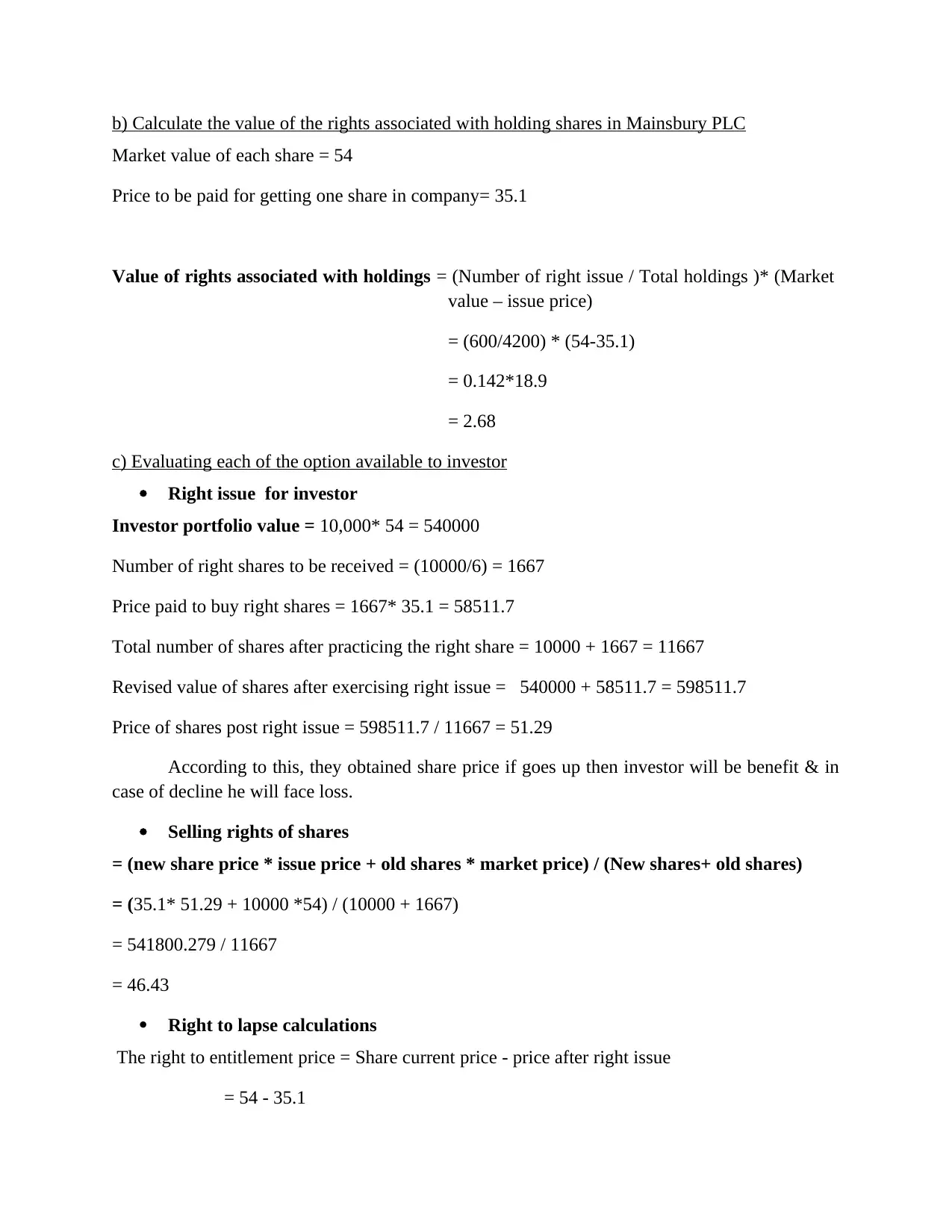
b) Calculate the value of the rights associated with holding shares in Mainsbury PLC
Market value of each share = 54
Price to be paid for getting one share in company= 35.1
Value of rights associated with holdings = (Number of right issue / Total holdings )* (Market
value – issue price)
= (600/4200) * (54-35.1)
= 0.142*18.9
= 2.68
c) Evaluating each of the option available to investor
Right issue for investor
Investor portfolio value = 10,000* 54 = 540000
Number of right shares to be received = (10000/6) = 1667
Price paid to buy right shares = 1667* 35.1 = 58511.7
Total number of shares after practicing the right share = 10000 + 1667 = 11667
Revised value of shares after exercising right issue = 540000 + 58511.7 = 598511.7
Price of shares post right issue = 598511.7 / 11667 = 51.29
According to this, they obtained share price if goes up then investor will be benefit & in
case of decline he will face loss.
Selling rights of shares
= (new share price * issue price + old shares * market price) / (New shares+ old shares)
= (35.1* 51.29 + 10000 *54) / (10000 + 1667)
= 541800.279 / 11667
= 46.43
Right to lapse calculations
The right to entitlement price = Share current price - price after right issue
= 54 - 35.1
Market value of each share = 54
Price to be paid for getting one share in company= 35.1
Value of rights associated with holdings = (Number of right issue / Total holdings )* (Market
value – issue price)
= (600/4200) * (54-35.1)
= 0.142*18.9
= 2.68
c) Evaluating each of the option available to investor
Right issue for investor
Investor portfolio value = 10,000* 54 = 540000
Number of right shares to be received = (10000/6) = 1667
Price paid to buy right shares = 1667* 35.1 = 58511.7
Total number of shares after practicing the right share = 10000 + 1667 = 11667
Revised value of shares after exercising right issue = 540000 + 58511.7 = 598511.7
Price of shares post right issue = 598511.7 / 11667 = 51.29
According to this, they obtained share price if goes up then investor will be benefit & in
case of decline he will face loss.
Selling rights of shares
= (new share price * issue price + old shares * market price) / (New shares+ old shares)
= (35.1* 51.29 + 10000 *54) / (10000 + 1667)
= 541800.279 / 11667
= 46.43
Right to lapse calculations
The right to entitlement price = Share current price - price after right issue
= 54 - 35.1
⊘ This is a preview!⊘
Do you want full access?
Subscribe today to unlock all pages.

Trusted by 1+ million students worldwide
1 out of 20
Related Documents
Your All-in-One AI-Powered Toolkit for Academic Success.
+13062052269
info@desklib.com
Available 24*7 on WhatsApp / Email
![[object Object]](/_next/static/media/star-bottom.7253800d.svg)
Unlock your academic potential
Copyright © 2020–2025 A2Z Services. All Rights Reserved. Developed and managed by ZUCOL.




